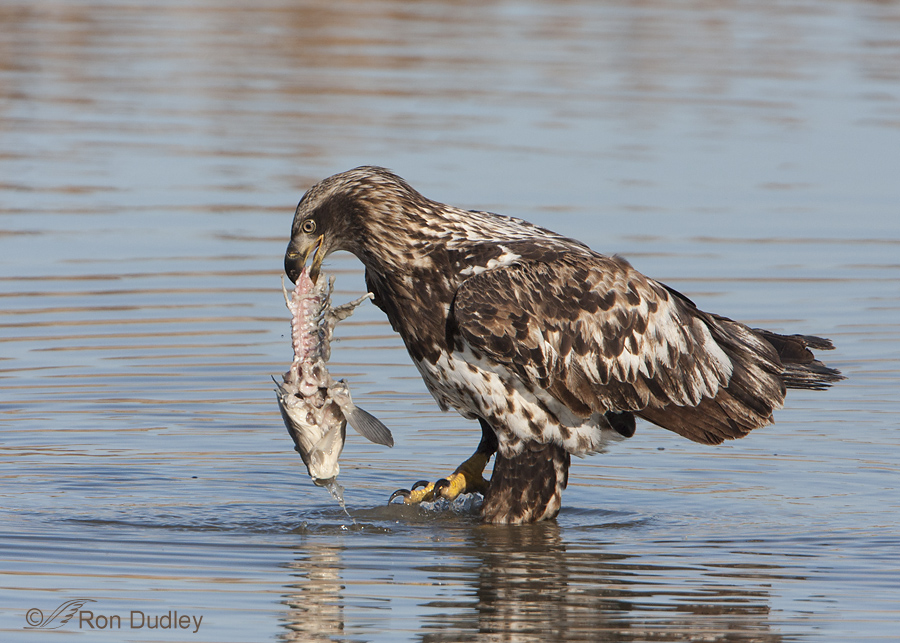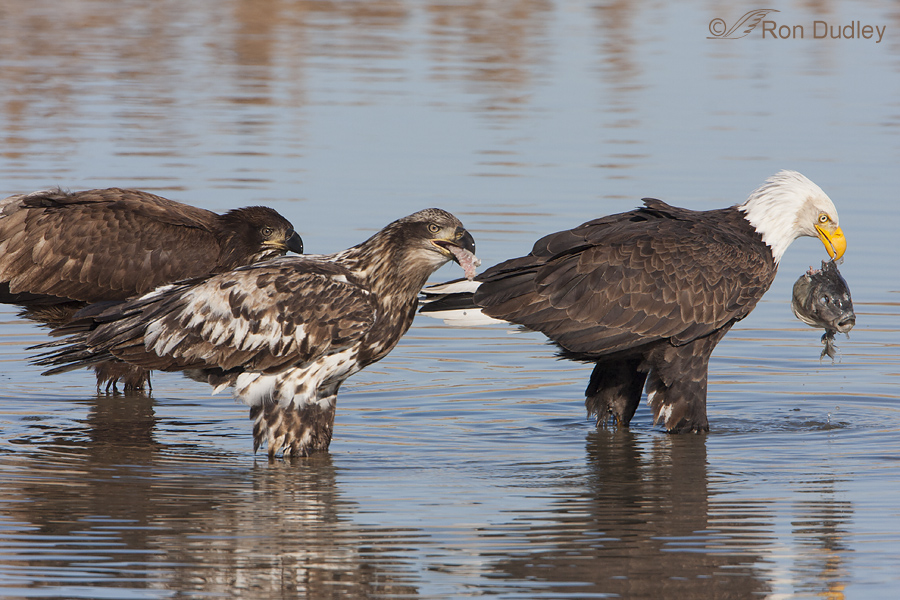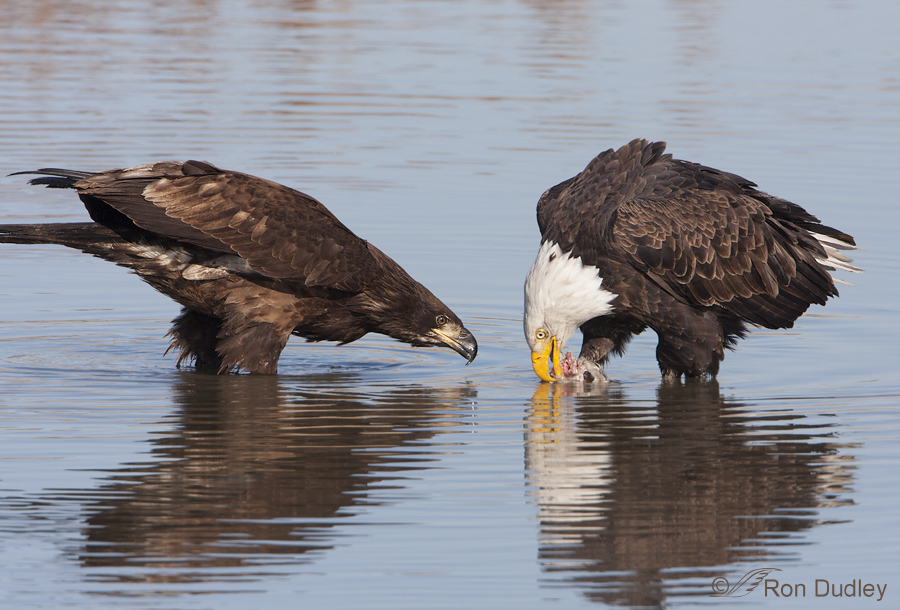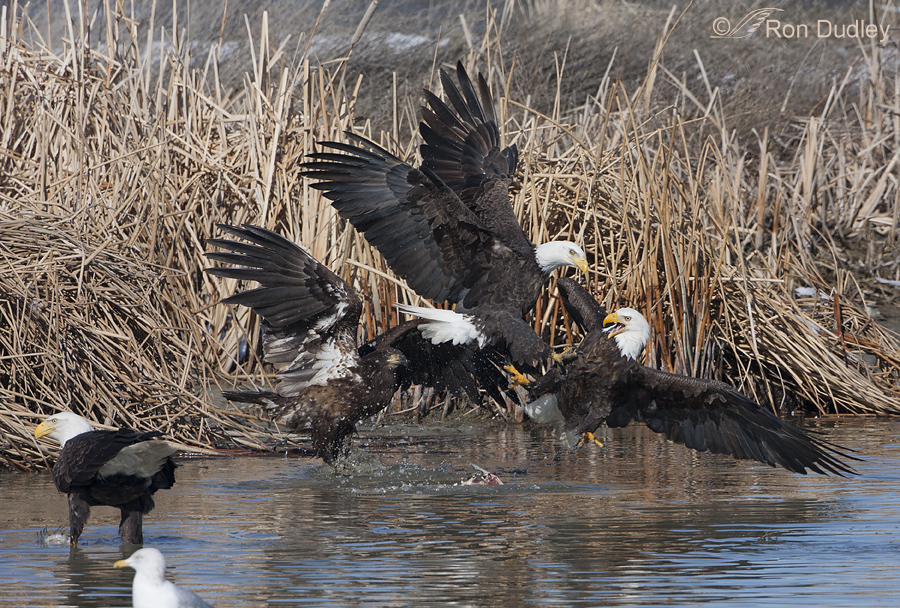For years managers at Farmington Bay WMA have killed carp as a management tool. The dead fish bring in hundreds of Bald Eagles but this year, because of the West Nile Virus outbreak in the eagle population, managers had to decide whether or not to proceed with the fish kill. That decision has been made.
First a little background. Because of the aggressive way carp root in the mud of the wetlands they cause significant damage to the emergent vegetation required by waterfowl for nesting and cover. Managers use rotenone to control the carp population. Rotenone is a natural substance that is not a poison in the classic sense – it simply prevents oxygen from moving through the gills of the fish so they die of asphyxiation. The rotenone is expensive and it dissipates quickly so it is used during winter when low water temperatures make its effect last longer.
Up to 1250 (sometimes more) Bald Eagles overwinter in Utah and hundreds of them are typically drawn to Farmington Bay in late January and February for the fish smorgasbord. This mass congregation provides a real treat for birders, nature lovers and photographers. And eagles aren’t the only avian participants in the feeding frenzy – thousands of gulls of many species (some unusual for our area) also join in the feast. These gulls are a big draw for birders.
These photos were all taken at Farmington soon after a carp kill and should give you a feeling for what it’s often like there in late winter.
This immature Bald Eagle had eaten its fill but instinctively guarded its fish from other birds by carrying it from place to place in the shallow water.
Here, two immature eagles of different ages (on the left) crowd around an adult and pick up tidbits it leaves behind.
This young bird was really pushing its luck as it tried to snatch away some of the fish. The adult threatened it several times but eventually the juvenile was rewarded for its efforts with some fish skin.
Serious fights over carp are fairly common so there’s lots of interesting action to be observed and photographed. Here you can see a carp below the two fighting adults and another one being guarded by the eagle on the left. Gulls are ever-present, waiting for an opportunity to snatch away any morsels they can.
But this year things will be dramatically different at Farmington Bay as managers have made their decision and carp will not be killed in northern Utah (including Farmington) this winter. Approximately 60 Bald Eagles are confirmed dead from West Nile Virus and others are still in rehabilitation. It’s very likely that there are more dead eagles that have not been found. Most dead eagles have been found by hunters but duck hunting season has recently come to an end so it’s probable that few if any more will be located.
The effects of West Nile Virus in eagle populations are not well understood but since it’s known that the virus, whose typical vector is mosquitoes, can also be spread through feces and saliva it was deemed best to not take a chance by artificially congregating large numbers of eagles at Farmington. This will be a huge disappointment to many but the chance just wasn’t worth taking.
The rationale for the decision is complex (and even somewhat controversial) and beyond the scope of this blog post but if you’re interested in more details I include this link to the USGS press release on the subject.
Carp were deliberately introduced into northern Utah in the late 1800’s and they wreak havoc in many of our waterways and lakes. They’re particularly troublesome in Utah Lake and the state is in the process of removing 5 million pounds of them annually in an effort to have them under control by 2017. More on the Utah Lake effort here if you’re interested.
This decision will likely be old news to some of my blog followers but since many birders and photographers travel from out of state to witness this spectacle I thought a report on the decision was appropriate.
Ron






So, will Farmington Bay still have a Bald Eagle Day this year? (2014) If they do, does anybody know what to expect? I’m having a hard time finding information on it! (awesome pictures bytheway.)
So..is there going to be a Bald Eagle Day at Farmington Bay this year?(2014) I really can’t find good information about it. Will there be any eagles to see if they DO decide to have one?
Jo, Last I heard they’re still having Eagle Day in several places in northern Utah but I strongly doubt there will be many eagles at Farmington and the few that are there will likely be far out on the ice as they have been for a while now.
Great set of action photos! but also very informative text to explain the issues.
Ron ..my first visit to your blog and I’ve really enjoyed your fabulous Bald Eagle introduction! You were certainly in the right place at the right time; and wonderfully crisp photographs.
Thanks for the information, Ron.
I commend the decision to keep from congregating the birds until they have a better understanding of the current outbreak of West Nile in the Bald Eagle population and if it is impacting other scavengers.
I’m sorry for the loss of the food source for the birds, but I’m glad that they are not importing additional dead Carp from Utah Lake to intensify the congregation.
I’m seeing about the same number of Bald Eagles and Golden Eagles as last year, here on the Wasatch Back. There does seem to be an uptick in the number of Rough-legged Hawks here this year, however.
Great Images as usual.
Neil
Great write up Ron
Thank you for another very interesting and entertaining entry. Poor birds. Last year it was starving owls and this year it is a devastating disease. Seems like the birds are having a tough time. I can only hope things improve.
Thanks, Tana. And yes, I hope our raptors are due for a break, very soon.
I especially like the third image as it very clearly shows so many of the differences between juvenile and mature birds…ex. darker, brown eyes in juvenile,lighter, yellow in mature; blackish beak in the juvenile, the yellow one in the mature, the dark head of the younger bird, the white (“bald”) head of the older, mature one , and the solid body color of the older bird vs the blotches of white on the younger one. the ” spotted eagle”, the wambli gleska…
Patty, check out the link Louise provided, below.
Ron, the photo of the Eagles fighting reminds me that I NEVER want an Eagle ticked off at ME. Dang! Ouch!
Thank you again and again!
Agreed, Mikal. They’re rather formidable looking birds, aren’t they?
Wonderful photography and interesting info. Ron!
I hope the feathers of the dead birds were sent to the National Repository in DC so that the Native Americans will have access to them.
Charlotte
That’s something I hadn’t thought of, Charlotte. I don’t know if they were or not.
I echo Charlotte Norton’s hope that the feathers be released to native people…it would mean so much to them…I hope they do it….
You can rest assured, Patty and Ron. It is the law – ALL eagles are sent to the eagle repository in CO for distribution, whether they die in care at a rehab center, a zoo, are found in the field, or, I’m sure, at the lab. We have to get permission to do necropsies on eagles, and then the pathologist is asked to do a ‘cosmetic necropsy’ (open the carcass in such a way that it can be closed again, so that it can be passed on to the repository and used). Native Americans use more than just the feathers – but also the head and feet and even some of the bones. We are not allowd, even with the permits we have, to keep any part of an eagle. SO the artifacts we have for children to touch will be real preserved hawk or owl feet, wings, skulls, bones, but are eagle artifacts are all replicas. Just an FYI!
Also just wanted to comment on eagle fights – they are lethal to each other. Although rehabilitators do get in eagles hit by cars, shot, poisoned, etc., we also get a fair number nationwide that have been in territorial or food disputes. They can do a tremendous amount of damage to each other.
AND in terms of aging, as shown in the photo of the first year, 2nd or 3rd, year and full adult – sometimes it’s not as clear cut. We currently have a bird in care with almost a full white head and tail BUT she still has a dark beak (just barely beginning to turn yellow) and dark eyes. Very striking! I don’t think we can post photos in these comments, but a photo is on our facebook page http://WWW.facebook.com/eRaptors from January 14th, for anyone interested.
Thank you very much for the background info on eagles sent to the repository and fighting, Louise. Fascinating and useful information.
And your female bird with the mix of adult and juvenile traits is a real eyeful! I’d encourage others to click on your link to see for themselves – very much worth the visit!
An interesting link. Thank you. I know how the feathers are used, ex.in regalia,dance, reward and prayer, and that the wing bones are used for whistles, but was unaware how any other bones, or the skulls are used. Either way, I”m glad they do go the tribes. Even when you’re on the waiting list,It can be a fairly long wait.
I’lI be watching this one…hoping things work out well for all. I always get nervous when “experts” decide to “manage” environmental situations…a little like watching the Army Corps of Engineers “improve” something…but it could be awfully risky to attract large numbers of eagles to an identified source of West Nile…I guess we wait and see…and hope for the best….Love pictures of the “dirty birds”, wambli gleska, juveniles….
I’m glad you like the juvies, Patty. I don’t think they get the respect they deserve…
Ron, good report. As you said, it’ll be interesting to monitor the eagles this year. The carp will still be there for them, just not as easily available.
Thanks, Wally. Actually the eagles have very little opportunity with the live carp. They’re mostly under the ice and a high percentage of them are too large for eagles to handle/kill.
I find myself wondering how many eagles will return anyway, out of “habit”, because they’ve been there and fed successfully before…and if they do return, in what numbers ;what they will feed on if the carp are under the ice and unavailable, and what this competition for food will mean to other migrant and resident species….yet, what other choice was there…
There’s already some out there, Patty and they’ve been there for a while. It’s my guess that lots more will filter in slowly, check things out and then leave again when they don’t find the carp. I doubt they’ll be there in large numbers at the same time. But that’s only a guess and only time will tell.
BTW, thanks Ron for the background info on the carp kill. Your photos of the awesome too !. It is a great photographic opportunity, however, I am happy to hear that thoughts for the health of eagles comes first.
You’re very welcome, Ed.
I am happy to hear about this decision. Perhaps some of the science curious raptor lovers in Utah can try and collect some data on how many eagles show up anyway this year, in particular within a time window around where the Eagle Day(s) occur and in the places where the carp kills happen. It would be interesting to collect some data on learned behavior of raptors from “baiting”. There is some evidence with Mexican Spotted Owls that only after a couple of mouse feeds by authorities doing surveys, the owls come beg on previous year when they see a truck or person in their territory. Anyway, just an idea.
Ed, I’m sure there’ll be a lot of interest in collecting such information – among both managers and the public. I know I’ll be paying attention to it myself. I too think it’s the right decision, based on what we know and what we don’t.
I counted 2,500 eagles a few years ago out there on a survey. It can be spectacular, I’ll miss the eagles. And the photographer-haters will be happy about the decision….?
Wow, that’s a bunch, Jerry. I’ve never seen that many but then I usually couldn’t get past the 4-way – I’m sure there were lots more of them to the south, east and west. We did once help Justina with an eagle count past the gated areas and that was really fun. Agreed about how some folks feel about photographers – if a few of them were on better behavior out there it would sure reflect better on the rest (majority) of us…